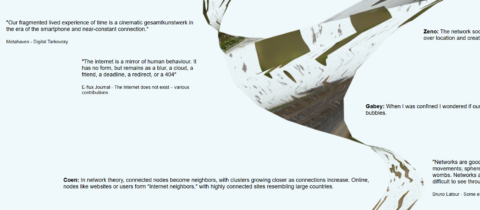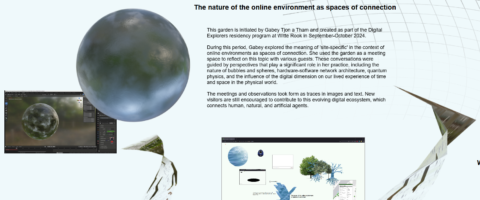19 December 2024
Article
‘What is the nature of the online environment?’ – Gabey Tjon a Tham’s online working period at Witte Rook

With the sensory and physical experience of environments as a starting point, artist Gabey Tjon a Tham explores how the digital world influences our perception of the physical world. Up until a few years ago, Gabey created kinetic sculptures that became audiovisual installations through the mechanical eye of the camera. Around the covid pandemic, her work shifted to the digital domain. She uses the open source software Blender (blender.org) and the cross-platform game development software Unity 3D (unity.com) to make digital doubles of physical environments that respond to the weather and the time of day through the use of sensors. This is how she shows the abstract underlying layers of technology, or how the computer looks at those specific physical environments.
During her online working period as Digital Explorer at Witte Rook Gabey worked from a digital environment. One of the requirements of the working period was to work within Constant Dullaart’s platform common.garden. Dullaart founded this platform in 2020. Because of covid, most of social life was moved to the online domain, this is why it was important to create a meetingplace free from advertisements and tracking. From the beginning, Gabey has used her garden as a place for research. By approaching this as an ecosystem with natural and artificial players, her garden is constantly changing due to the interactions that take place within it.
One of Gabey’s sources of inspiration is quantum mechanics. In this scientific model the world exists only through interactions. Particles, things and beings are connected to and originate through relational occurrences. “In quantum mechanics, the physical world is comprised of interactions, processes and relations. Borders do not exist, because the particles are always in motion,” Gabey explains. Thomas Herzog and Stephen Hawking’s research methods especially inspire Gabey, because they approach humanity as a part of the universe and therefore eliminate the separation of man from nature.

Screenshot common.garden Gabey Tjon a Tham
Gabey set up the common.garden she developed during her working period as a space for connection. Departing from a collection of pieces of text that she has read in the past few years, and conversations she has had with artists, researchers and digital professionals. She calls this collection the “root” of her garden. After the meetings, Gabey invited her conversation partners to leave behind a reflection in the textbox: “What does site specific mean in the digital realm?” Pieces of those responses have become new roots. They are the beginnings of new branches that open new perspectives on the local specificity of the digital. How this site specificity can manifest itself in the online environment is Gabey’s guiding question in this process.
In her garden various forms of rationalities exist together. On the left hand side a slideshow of former version of Gabey’s garden is on view, an “archive in time” as she calls it. It begins with a black hole, continues through line drawings, into rational elements that are assembled from interactions. Another text box invites the visitor to discover the trees that they can see looking out of their own window. Gabey has modeled these trees in Blender and placed them in the garden, where a digital forest is now growing. “I found a good way to bring together different physical locations online. In addition, the trees are inspired by ‘quantum trees’, as described in Thomas Hertog’s book On the Origin of Time: Stephen Hawking’s Final Theory. The roots of the quantum trees represent different possibilities of the past, and the branches in the crowns reveal diverse possibilities of the future. “Both can come about through interactions and observations,” Gabey explains. Between the recognizable trees Gabey has placed 3D renders. Trees that reflect their environment, but do not (yet) belong to a specific species.
As well as the 3D-rendered trees, spheres, meshes, and twisted planes are placed in the environment of the garden. Spheres are typical elements from the digital 3D-modeler environment. Meshes determine the shape of 3D objects that underlie the material that eventually forms the object. The fact that Gabey also shows screenshots of the 3D objects in the Blender environment itself makes clear what is reflected in their surfaces. Gabey describes: “I have purposefully used the standard Blender environment, a bos, because it shows the nature of the software. The objects themselves are transparent, they need to reflect their environment to become visible.”

Screenshot common.garden Gabey Tjon a Tham
For years Gabey was inspired by the Spheres philosophy of Peter Sloterdijk, a German philosopher and cultural theoretician. In his books he shows the diversity of intertwining human experiences, cultural developments and historical events. He describes that we as humans cannot but create spaces. Through his theories Gabey developed more empathy for what online spaces can add to our human existence. “He describes that we as people can use technologies to create shared spaces. That if an attempt is made to repair our connection to others, which we lost at the moment of birth,” Gabey explains. In an interview Sloterdijk calls this isolated connection.
In her ‘garden’ every visitor is an egg that moves with the cursor. When visitors come together in the ‘garden’ and their eggs are near each other in the online environment they can all talk to each other. During her online presentation on November 28th Gabey will guide the visitors through the ‘garden’. Everyone will follow Gabey’s egg in their own way, slow or fast, with the mouse or the keyboard. One can see how the eggs move through the space and what the mannerisms are, this creates a curious digital corporality.
Gabey has already welcomed many visitors in her ‘garden’, and wants to continue doing this in the future. It is her way to show her research and to share it with others that cannot come on a studio visit. Working digitally has given Gabey a lot of new freedoms. It has become an intuitive process for her. In the past she would make physical prototypes of her work, digitally she can move on to the testing phase sooner and see more quickly what she is doing.
Nevertheless, she does not think it is necessary to compare the online and the physical worlds with one another, because they will never replace each other. It is much more interesting to ask, what the natures of online and digital environments are, and what other perspectives these can give us in relation to our connection to one another. “I would like people to be able to internalize the thought process of quantum mechanics. It shows us that on the smallest scale, everything is fluid and rational, without borders or the idea that every object stands on its own. I think that this view is essential for the time in which we find ourselves.”
